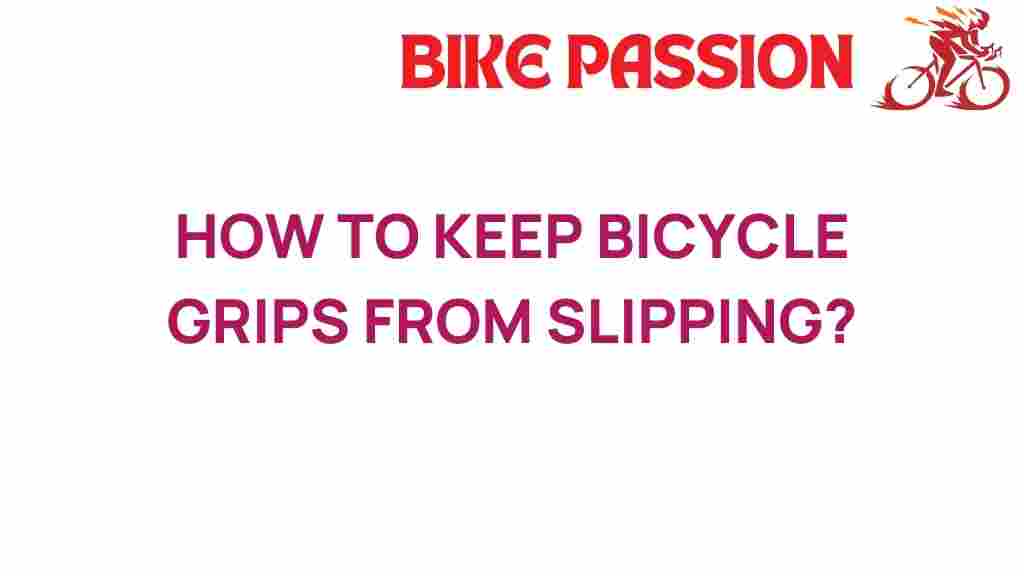Mastering Bicycle Grips: How to Prevent Slipping for a Safer Ride
When it comes to cycling, the grip you maintain on your handlebars is crucial for both safety and performance. Bicycle grips play a pivotal role in ensuring that your hands do not slip during your ride, which can lead to accidents or loss of control. In this article, we’ll explore various aspects of bicycle grips, including how to prevent slipping, maintenance tips, and essential cycling tips to enhance rider comfort. If you’re looking to improve your biking experience, understanding the importance of your grips and knowing how to maintain them is vital.
Understanding Bicycle Grips
Bicycle grips are the coverings on the handlebars that provide a surface for the rider to hold onto. They come in various materials and styles, each offering different levels of comfort and grip. Here’s what you need to know:
- Material: Grips can be made from rubber, foam, silicone, or even leather. Each material has unique characteristics that affect grip and comfort.
- Style: There are numerous styles, including ergonomic grips designed to reduce strain, and traditional straight grips.
- Size: The diameter of grips can vary; choosing the right size is essential for comfort and control.
Why Slipping Occurs
Slipping can occur due to several factors:
- Moisture: Sweat or rain can make grips slippery.
- Wear and Tear: Over time, grips can become worn, losing their texture and grip.
- Improper Installation: If grips are not properly installed, they may rotate or move during rides.
Steps to Prevent Slipping
To ensure that your bicycle grips provide optimal performance and safety, follow these steps:
1. Choose the Right Grips
Select grips that suit your riding style and hand size. If you ride in wet conditions often, look for grips with a textured surface or those specifically designed for wet weather.
2. Proper Installation
Ensure that grips are installed correctly. If they are loose, they may slip during use. Here’s how to install them properly:
- Clean the Handlebars: Remove old grips and clean the handlebars.
- Apply Grip Tape: For extra security, consider using grip tape underneath the grips.
- Use a Secure Adhesive: Apply a small amount of adhesive or grip glue to the inside of the grips before sliding them on.
- Ensure a Tight Fit: Push the grips firmly onto the handlebars, ensuring they are snug.
3. Regular Maintenance
Regular maintenance of your grips is essential for long-lasting performance. Here are some maintenance tips:
- Clean Grips: Wipe down your grips regularly to remove dirt, sweat, and grime.
- Inspect for Wear: Check for cracks or excessive wear, and replace grips if necessary.
- Check for Loose Grips: Periodically check that grips are secure and reapply adhesive if needed.
4. Use Grip Enhancers
If you find that your grips are still slipping, consider using grip tape or grip enhancers. Grip tape can be applied directly to the handlebars or over existing grips to provide additional friction.
5. Adjust Riding Technique
Sometimes, slipping can be mitigated by adjusting your riding technique:
- Hand Position: Keep your hands firmly on the grips, especially when riding downhill or during bumpy conditions.
- Relax Your Grip: Holding on too tightly can lead to fatigue. Find a comfortable grip that allows for better control without excess tension.
Troubleshooting Common Issues
Even with the best grips and maintenance, issues can still arise. Here are some common problems and how to troubleshoot them:
Problem 1: Grips Are Slipping During Rides
If your grips are slipping despite installation and maintenance, try the following:
- Check the installation and ensure they are tight.
- Reapply grip tape or adhesive.
- Consider switching to grips with a more textured surface.
Problem 2: Hand Discomfort and Numbness
If you experience discomfort or numbness in your hands, it might not just be the grips:
- Check the diameter of your grips; they may be too thick or too thin for your hands.
- Consider ergonomic grips that provide better support.
- Adjust the position of your handlebars to ensure a comfortable riding posture.
Problem 3: Grips Wearing Out Quickly
If your grips are wearing out faster than expected:
- Evaluate the material of your grips; some are more durable than others.
- Consider the frequency and type of riding; aggressive mountain biking may lead to quicker wear.
- Regularly clean your grips to prolong their life.
Other Bike Accessories for Enhanced Safety and Performance
While focusing on your bicycle grips is crucial, it’s also important to consider other accessories that contribute to safety and performance:
- Handlebar Tape: For road bikes, handlebar tape can provide additional grip and comfort.
- Gloves: Wearing cycling gloves can enhance grip and protect your hands from blisters.
- Reflectors and Lights: Ensure you are visible to others, especially when riding at night.
- Helmet: Always wear a helmet to protect your head in case of falls.
For a more in-depth look at bike accessories, check out this comprehensive guide on essential cycling gear.
Conclusion
Mastering bicycle grips is essential for a safer and more enjoyable ride. By understanding the importance of your grips, selecting the right ones, and maintaining them properly, you can significantly reduce the risk of slipping. Remember, your grips are not just about comfort; they play a vital role in your safety while cycling.
Incorporate these cycling tips into your routine to enhance your performance and ensure a more comfortable ride. Don’t forget to keep an eye on your grips and other bike accessories to maximize your cycling experience. For more tips on cycling safety and gear, visit Cycling Safety Tips.
This article is in the category Maintenance and created by BikePassion Team
